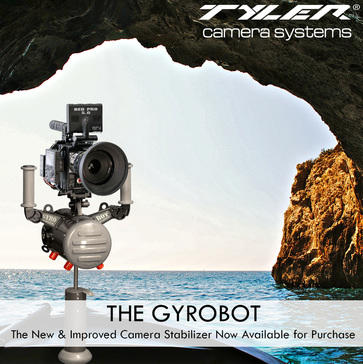
Both motion picture and television audiences respond to astounding pieces of cinematography. This is most noticeable during a sweeping shot over a sandy beach. The same concept is applied during overhead shots of a freeway chase taken from a helicopter.
The ability to produce a flawless shot is the major advantage offered by today's technology. Steady camera shots can be obtained while the camera itself is in movement. The camera can be moving on land, the water or in the air. Audiences no longer have to endure shaky still photography or videos that literally cause motion sickness.
One method filmmakers use to create photography while in constant motion is with a small stabilizing camera mount known as a “Gyrobot.” Unlike the much larger camera mount unit or “steady cam” popularized in the '80's, the Gyrobot is a stabilizing mount available for purchase. As a slim weight camera mount, it can be affixed to equipment as varied as a 35 millimeter camera to a GoPro video camera.
The Gyrobot stabilizing camera mount is a lighter version of the Minigyro stabilizing mount; a unit only available for rental. While both camera mount units are small and lightweight, they do vary. The body of the Gyrobot is composed of aluminum and carbon materials, unlike the Minigyro with its aluminum/abs body. This enables Gyrobot to be two pounds lighter than its Minigyro camera mount counterpart.
What gives the Gyrobot the advantage as a stabilizing mount comes with its light weight body at only 21 pounds (including its shock tube) versus the Minigyro that weighs in at 23 pounds. The Gyrobot stabilizing mount is also able to support the weight of a camera package when not aloft with use of its four small legs.
Both the Gyrobot and Minigyro have certain things in common as camera stabilizing mount units. They can each hold a camera package weighing up to 32 pounds. With a two pound nonlinear shock tube, shock tube extender and 2 KS-8 Kenyon Gyros, shots are exceptionally level.
Wrapping up a shoot also becomes time-efficient with the quick release camera tray that comes with both of these models. Each of these stabilizing camera mounts has an adjustable hand grip for easy use and a camera head that tilts to grab that shot. Traveling to your location with your stabilizing camera mount can be accomplished safely, with a water tight shipping case on wheels.
The ability to produce a flawless shot is the major advantage offered by today's technology. Steady camera shots can be obtained while the camera itself is in movement. The camera can be moving on land, the water or in the air. Audiences no longer have to endure shaky still photography or videos that literally cause motion sickness.
One method filmmakers use to create photography while in constant motion is with a small stabilizing camera mount known as a “Gyrobot.” Unlike the much larger camera mount unit or “steady cam” popularized in the '80's, the Gyrobot is a stabilizing mount available for purchase. As a slim weight camera mount, it can be affixed to equipment as varied as a 35 millimeter camera to a GoPro video camera.
The Gyrobot stabilizing camera mount is a lighter version of the Minigyro stabilizing mount; a unit only available for rental. While both camera mount units are small and lightweight, they do vary. The body of the Gyrobot is composed of aluminum and carbon materials, unlike the Minigyro with its aluminum/abs body. This enables Gyrobot to be two pounds lighter than its Minigyro camera mount counterpart.
What gives the Gyrobot the advantage as a stabilizing mount comes with its light weight body at only 21 pounds (including its shock tube) versus the Minigyro that weighs in at 23 pounds. The Gyrobot stabilizing mount is also able to support the weight of a camera package when not aloft with use of its four small legs.
Both the Gyrobot and Minigyro have certain things in common as camera stabilizing mount units. They can each hold a camera package weighing up to 32 pounds. With a two pound nonlinear shock tube, shock tube extender and 2 KS-8 Kenyon Gyros, shots are exceptionally level.
Wrapping up a shoot also becomes time-efficient with the quick release camera tray that comes with both of these models. Each of these stabilizing camera mounts has an adjustable hand grip for easy use and a camera head that tilts to grab that shot. Traveling to your location with your stabilizing camera mount can be accomplished safely, with a water tight shipping case on wheels.